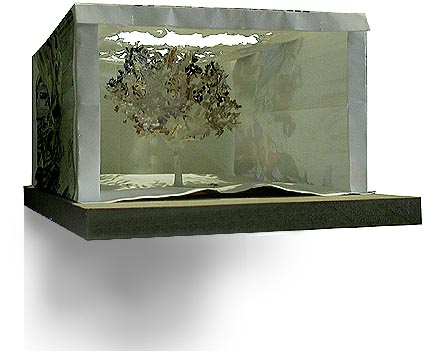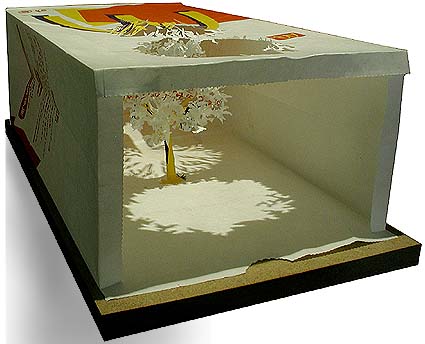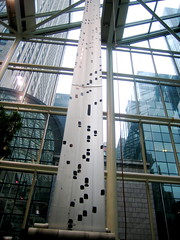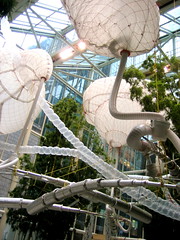Remapped Realities at Eyebeam
Artists Exhibiting in Remapped Realities at Eyebeam:
Eyebeam is an appropriate place for a video installation exhibit because they have the space to contain all the pieces and have them exist independently of each other, without the accidental influence that other video installation exhibits tend to have when they are installed in a limited space. Eyebeam installed each of the pieces in Remapped Realities in their own room, and all the pieces sounds were self-contained, there wasn't much sound leaking from one piece into another. All of the pieces addressed very different ideas and each had their own individual techniques. There wasn't the problem that plauges many installations where the videos all have such a similar aesthetic that the work seems to be produced by the same artist even though they were produced by individual artists.
Aziz + Cucher -
 Synaptic Bliss: Villette
Synaptic Bliss: VilletteAt first this piece didn't strike me as quickly as Caspar Stracke's piece, because its nature does not provoke an immediate response. Sitting through the piece and experiencing its progression is this piece's strength. The forms of Syaptic Bliss resemble that of cells and the shift in seasons. The masking and composition of the piece is very smooth and the progressions are very dynamic.
Michele Barker -
 Struck
StruckThis was a narrative piece about "understanding disease through the visual interpretation of data" (Eyebeam.org, 2005) in the context of a woman waking up in another woman's body. This piece did not draw me in so much because I didn't find the presentation of form and narrative very persuasive. The rendering of the text for the narrative from blurry to readable seemed too obvious and created an unnecessarily slow pace.
Andreas Berner -
 Moments
MomentsThe scenes in this piece reminded me of the Little Prince, the notion of a character exploring his environment and contemplating memories.
Bret McConnell -
 The Jonses
The JonsesI felt like this work was overshadowed by all the other pieces because of its obvious nature. It didn't unfold or exhibit a multi-layered process like the rest of the work, and it was installed in hallways on the way to other pieces, which made these pieces missable.
Shirin Neshat -
 Making of Mahdokht
Making of MahdokhtA documentary about Neshat's first feature film "Women Without Men," based on a novel written by an Iranian writer, Shahrnoush Parsipour. This video piece was a film of a film being made, a meta-narrative of sorts. The scene in the image above, is one of the most striking scenes in the piece, wherein a woman is sitting on the ground in a forest knitting amongst a huge pile of yellow yarn.
Caspar Stracke -
 P.O.P.
P.O.P.P.O.P stands for Points of Presence, a video installation mounted on a rotating hangar wherein both sides of the screen had projections of transposition of New York, Mexico City, Berlin and Shanghai. Each scene of video from a specific city would eventually be spliced by another scene from another city, producing a flow of elements of familiarity from similar elements of the cities. This piece demonstrates ideas of the life and premise of capitalistic development of cities from the book Mutations, which I am currently reading and did buy at the Remapped Realities exhibition.


























